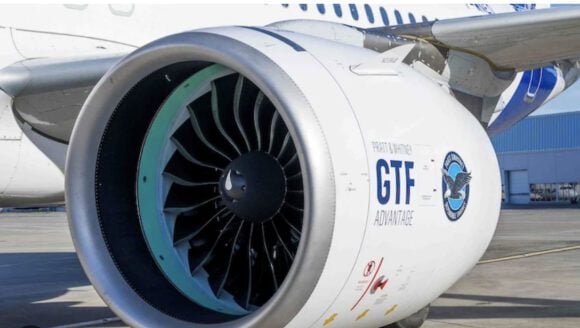Pratt & Whitney and IBM have joined forces to advance the state of the art in Big Data and the Internet of Things by tackling issues posed by engine health monitoring data head on. New technologies, both in engine sensors and monitoring capabilities embedded in the new PW1000G to enter service later this year, and advances in data storage and information technology that enable better analysis have converged to provide new opportunities in developing predictive analytics to enable airlines to keep engines on-wing longer and improve on-time performance.
The sensing technology within engines is improving, with more parameters monitored and broadcast on virtually a continuous basis every second that an engine is running. Today’s engines, such as the V2500, collect about 100 parameters at multiple snapshots in a given flight. The GTF will collect about 5,000 parameters continuously through a flight. That produces a staggering amount of data, about 2 pedabytes (a pedabyte is 1,000 terabytes) for the fleet every year. Simply storing and retrieving that data efficiently, not even analyzing it, is a challenge. IBM has stepped up to the plate in that regard, and PW has made significant investments in three areas; enterprise wide systems using SAP, direct attached storage with solid state disks and high performance drives while implementing parallel rather than sequential processing for their database, and the ability to aggregate both structured and unstructured data, whether it be a Word document or PDF that can be linked to the database as asynchronous data.
The goal, of course, is to operationalize all of this data to create value, in this case, reducing unplanned engine maintenance events. PW wants to be able to move from reactive maintenance today to pro-active maintenance in the future, driven by early warning from monitoring data that a component might fail, enabling replacement before it does.
Their vision has three parts, first, collecting all of the data provided by new engine health monitoring technologies; second to anticipate in-flight shut-down events and prevent them; and third to customize maintenance work scopes for individual customers and engines based on their utilization, operational environment, and operational practices.
With a joint project between PW and IBM, the data collection and retrieval structures are now in place for a huge increase in data reporting once the GTF enters service. The second element entails developing predictive analytics, and PW currently has 14 projects underway in that regard. One of the most promising is the reduction in in-flight shut downs, as their software has shown a 90% predictive accuracy, and PW believes that it can achieve a 50% reduction in shut-downs based on its predictive software.
That provides tremendous value to an airline, as it avoids potential flight cancellations and passenger disruptions. The third element brings into play factors such as the individual operating environment between city paris. For example, engines operating in the Middle-East tend to experience additional wear and tear from sand in the air, and factors such as climate, temperatures, and even airline operating procedures for take-off and climb-out impact engine wear. Utilizing big data to adjust for these conditions analytically can dramatically improve performance if factored into maintenance plans, which will be customized for each operator, and each aircraft based on the city-pairs it flies.
Apart from the benefit of better performance for an airline, predictive analytics can help airlines reduce their costs for managing an engine. Today a typical airline requires 10 people to manage a single engine type, as there are about 10 different job functions required. Advanced predictive analytics and big data might allow those tasks to be performed by a single person, dramatically reducing maintenance overheads.
Of course, the data are owned by the airline that purchases the airplane and its engines. Pratt & Whitney gains access to that data either through a power by the hour management contract (which should be about 80% of GTF deliveries versus 60% on V2500 and 40% on earlier engines) or specifically negotiating with those performing maintenance elsewhere. For those carriers on PBTH contracts, data will also be contrasted with overall fleet performance.
Why Now?
For Pratt & Whitney, the why now question has two answers. First, it is introducing a high technology engine in the GTF, and second, 2015 will be its low point for engines in service, as its older models retire more rapidly and the mix changes to the include the more capable new technology engines with higher data availability. With significant growth in installed base planned over the next decade (with more than 6,300 GTF engines on order) the convergence of technology capabilities and market position made development initiatives imperative.
The Bottom Line
As technological sophistication increases, the airframe and engine OEMs are each introducing new heath management systems that should dramatically improve maintenance cost through predictive analytics and sophisticated modeling. The level of investment required to replicate such capabilities is not feasible for third-party independent MROs, and provide a compelling value-added for OEM maintenance management contracts.
As a result, the level of sophistication of the technology available from OEMs will make it more difficult for independent 3rd party MROs to compete, as they will be unable to provide a similar level of service without the data. Unless the airline contracts with the OEM for predictive analyses, which will be included in maintenance contracts, but priced separately for those not under contract, that data will not be available.
A new barrier to entry in the MRO world has been created with big data that will result in additional MRO volume controlled by the OEMs. As a result, third party MROs will need to align with OEMs to participate in these programs as “authorized repair stations” for OEM by the hour contracts, or face a losing that business to others.
Views: 4




How much of the data can and should be offloaded and collected during flight, such that it can provide further benefits in diagnosis and proactive prognosis